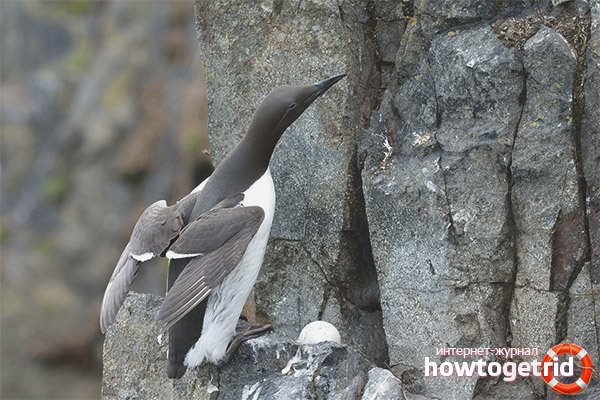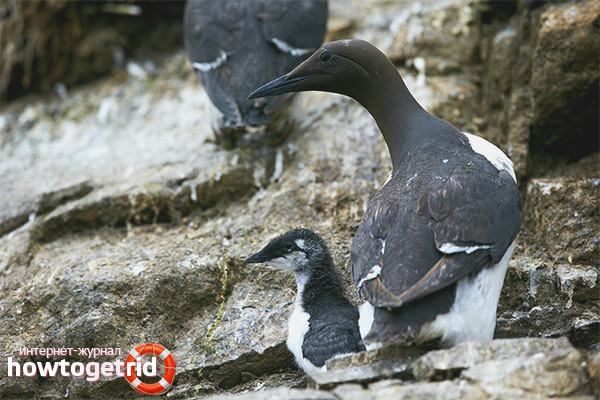The content of the article
A permanent resident of the far north of the guillemot belongs to the family of purebreds. These seabirds spend almost their entire lives in cold waters, getting out to land only during the nesting period. Kayra is widespread in the northern hemisphere. During breeding and laying eggs, the guillemot is selected on the rocky shores. They form quite large flocks, which are often called a bird market. The guillemot is similar to a duck in size, but has a completely different color.
Appearance of the guillemot bird
Today, the guillemot is the largest representative of the purebred family. In nature, there are two birds of this species - a thin-billed and a thick-billed murre. In terms of color, the guillemot is somewhat reminiscent of a penguin, it has the same black back and white abdomen. The neck is also black, but in winter the outfit in the neck becomes white. The size of the bird is about 40-45 cm, the weight usually does not exceed one kilogram, and the wingspan is about 70 cm. Regardless of the season, the beak always remains black with a thin white strip at the base. The beak of the murre is very strong, thick, sharp and bent down. The body of the thick-billed murre is quite wide in the upper part and tapers down. The tail is usually rounded and raised, like a real penguin.
Thick-billed and thin-billed guillemots are very similar in appearance, the main distinguishing mark is the size and thickness of the beak. In addition, the thin-billed murre has a shorter neck, it does not have gray speckles on the sides of the body, its color is more black. In addition, only the thin-billed representatives of the species have a characteristic white strip in the corners of the mouth. As a rule, a female from a male murre is no different, only in size. Thick-billed guillemots are generally a bit more massive. Despite the fact that both representatives of the species are quite similar, the guillemots almost never interbreed, preferring to choose a partner only from among their own subspecies.
Northern habitat
As noted, guillemots need northern seas and oceans, in which there are a lot of fish. The bird feels great even at the most extreme low temperatures. However, for normal life, the guillemot needs food and non-freezing water. The harsher the winter in the north, the closer to the south the guillemot moves during the winter. The habitat of the murre extends from the shores of the North Atlantic to the north of the Pacific Ocean and the coast of the Arctic Ocean. In the south side, the bird settles to Portugal, the British Isles, the Korean Peninsula, as well as to the northern part of Japan and California. Thick-billed guillemots prefer arctic waters more.
Guillemot lifestyle
Guillemots live in large colonies, are not afraid of people - they can let scientists close enough.The average life expectancy is about 30 years, although scientists recorded a case of a rather long life of guillemots - almost 43 years. In large schools, the thick-billed murre coexists perfectly with the thin-billed representatives of the species, visks, t-shirts and other birds. The main diet of guillemot is a fish of any varieties and sizes. In winter, when the fish becomes smaller, the guillemotters enjoy shellfish, mollusks, worms and other marine invertebrates with pleasure. Fish, as a rule, is eaten immediately after the catch - right under the water. On land, prey is carried out very rarely, only for feeding the chicks.
Reproduction of guillemot
Guillemots fly to nesting sites in late April and early May, choosing rocky shores for hatching. As such, the birds do not have a nest - the masonry takes place directly into the recess of stones. The guillemots lay one pear-shaped egg each. This form protects the egg from falling, because it has no other points of contact. An elongated and pointed egg can twist around its axis, but is unlikely to fall down the rocks. The color of the egg can be white, gray and even blue, each clutch is different in its pattern of inclusions and a hint of shell. Each egg is unique and parents easily recognize it among the rest of the offspring.
The guillemot's nesting site becomes permanent for her. Upon reaching the age of two, maturity sets in, males and females pick a mate. In a relationship, the guillemots are monogamous - they remain faithful to their partner for life. Throughout life they nest in one place, flying there again and again every year. The duration of the egg hatching is about a month. If a chick or an egg dies at some stage, the female can lay another clutch, up to three times per season. A month after the chick hatches, parents stimulate the kids to go down into the water, they teach them how to fish and escape from enemies. Together with their parents, the guillemots go on their first wintering.
Interesting facts about guillemot
Birds of this species are not shy, which allows you to more closely monitor their behavior and draw interesting conclusions.
- During the nesting period and on land, the guillemots are quite silent - they are busy with business. But at another time, among the large colonies of guillemots, they are very noisy and quarrelsome. Conflicts develop almost constantly. As a rule, males sort things out among themselves for owning a more attractive female. The fair sex is not far behind - they sort things out and fight for the best place to build a nest.
- The guillemots are very caring parents who feed them with small fish and shellfish from the first days of their life. Feeding stops a day before the kids will have to go down into the water. So guillemots stimulate chicks to hunt.
Sometimes guillemots can get along even without a shore; during migration, birds drift without problems on ice floes, dipping into water just to find food. - Kaira has no equal under water, it swims quickly, is perfectly controlled by wings, tail and paws, and is able to instantly change the trajectory of movement. Even the most brisk little fish will not leave such a predator.
- The male guillemot treats its lady very well - it helps her hatch her eggs, replaces her when the “mommy” goes to feed, protects her partner and chick.
- Even in the "womb", when the baby is in the egg, the parents gently tap on the shell. Thus, they establish a relationship, show their love to the baby, give information about the outside world.
- Some birds take care of the offspring of their neighbors. Unfortunately, the guillemots are not famous for this. If both parents are absent from the egg, no one will protect him from falling from a cliff.
In the natural environment, guillemots have virtually no enemies - due to the harsh climate.Most of the lost eggs are in turmoil when adults find out the relationship between themselves and crush freshly laid eggs. Often birds can fall into fishing nets or be crushed by ice floes. Often, eggs fall due to the fact that parents have chosen not quite a good place for laying. But these small and isolated incidents do not affect the growth of the population of thick-billed and thin-billed murre. Among predators, dangerous for chicks, there may be large species of gulls, arctic fox, raven, polar owl. For adults, such enemies are not terrible, but they can encroach on offspring.
Today, the guillemot population has more than a million pairs of individuals, which makes the bird one of the main links in the general ecosystem of the polar pole. Kayra is the largest representative of the Arctic. People in every possible way protect the bird in the territories of reserves in which the guillemot hibernates.
Video: guillemot (Uria)











Submit